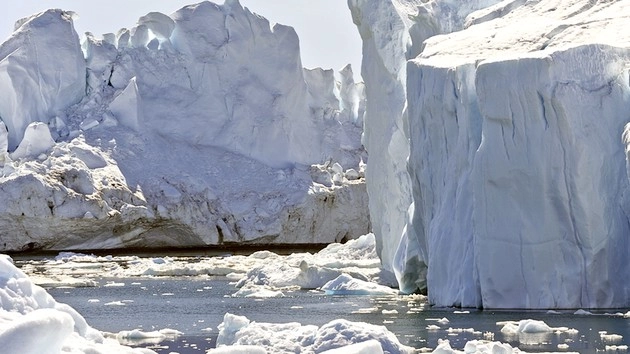Earthquakes have long been known to be one of nature's most devastating forces, causing widespread destruction and loss of life. However, in recent years, the frequency and intensity of these catastrophic events have escalated significantly. While the movement of tectonic plates beneath the Earth's surface has historically been the primary cause of earthquakes, it is now becoming clear that the effects of climate change are also playing a significant role. In this article, we will delve into the connection between climate change and earthquakes, examining how global warming is driving catastrophic seismic activity and exploring the potential consequences for our planet.
The following are the ways in which climate change is contributing to the increase in seismic activity:
Melting Glaciers: The melting of glaciers due to global warming is having a profound impact on the Earth's crust. As the weight of the ice decreases, the crust rebounds, causing stress on the tectonic plates. This stress can lead to an increase in seismic activity, and even trigger earthquakes.
A study published in the journal Nature in 2016 found that the rapid melting of glaciers in Greenland and Antarctica is causing the Earth's crust to warp and bend, which is increasing the frequency of earthquakes in these regions. In the Indian subcontinent, the melting of the Himalayan glaciers is causing landslides and mudslides, which can trigger earthquakes.
Changes in Groundwater: Climate change is causing changes in the distribution of groundwater. The increase in temperature is causing more evaporation, which is leading to changes in the water cycle. This can cause changes in the pressure on the Earth's crust, which can trigger earthquakes.
A study published in the journal Science Advances in 2021 found that the depletion of groundwater in California's Central Valley due to drought is causing the Earth's crust to sink, which is increasing the risk of earthquakes in the region. Similarly, the extraction of groundwater for human use in other parts of the world has been linked to an increase in seismic activity.
Sea Level Rise: The rise in sea level due to global warming is also affecting the Earth's crust. The weight of the water is causing the crust to sink, which can lead to an increase in seismic activity. In addition, the increased flooding caused by sea level rise can destabilize the ground, leading to landslides and other geological hazards.
The 2004 Indian Ocean earthquake and tsunami, one of the largest in human history with a magnitude of 9.1, was triggered by the movement of tectonic plates beneath the ocean floor. The resulting tsunami caused widespread devastation across the region, with Indonesia, Sri Lanka, India, and Thailand among the hardest-hit countries. Sea level rise also increases the risk of tsunamis, which can cause even more catastrophic damage.
Increased Storms and Extreme Weather: Climate change is causing an increase in storms and extreme weather events. These events can cause landslides, floods, and other geological hazards, which can trigger earthquakes.
In February 2022, a powerful earthquake struck northeastern Japan, with a magnitude of 7.1. The earthquake was triggered by heavy snowfall in the region, which caused landslides and other geological hazards. The earthquake caused significant damage to buildings and infrastructure, and injured over 100 people.
The strongest earthquake happened on 6 Feb 2023 in the Turkey; Syria region with a magnitude of 7.8 on the Richter scale. The shifting of tectonic plates in a depth of 17 km resulted in 51003 deaths. The earthquake also triggered a tsunami, leading to further victims and destruction.
Due to the melting of glaciers in the earth's crust, the distribution of weight changes Climate change increases the risk of tsunamis, volcanic eruptions and earthquakes. While the cause of the February 6 earthquake in Turkiye and Syria is currently unknown, there is growing scientific evidence that climate change is increasing the risk of such tremors.
UN adviser and environmentalist Professor Ibrahim Ozdemir explained that due to global warming, more and more glaciers are melting, which changes the distribution of weight in the earth's crust. In addition to the increase in earthquakes and the awakening of volcanoes, it can also affect the movement of the Earth's axis.
This particular consequence of global warming "warns us of a seismically turbulent future," Ozdemir emphasized.
NASA scientists also acknowledged in one of their reports on "Retreating Glaciers Spur Alaskan Earthquakes" that glaciers retreating due to global warming have been triggering earthquakes in Alaska in the past decades.
The impact is not limited to the Arctic. As melting glaciers change the distribution of weight across the Earth’s crust, the resulting "glacial isostatic adjustment" drives changes in plate tectonics that could lead to more earthquakes, awaken volcanoes and even affect the movement of the Earth’s axis.
Unfortunately, it is not just earthquakes. Climate and weather-related disasters have surged five-fold over the past five decades, killing over two million people, with 91% of the casualties in developing countries. And it is only getting worse.
The link between climate change and earthquakes is becoming increasingly evident. As global warming continues to impact the Earth's systems, we can expect to see more frequent and severe seismic activity. The devastating consequences of earthquakes on communities and infrastructure cannot be overstated. We must take urgent action to address the root causes of climate change, and mitigate its impact on the planet.



